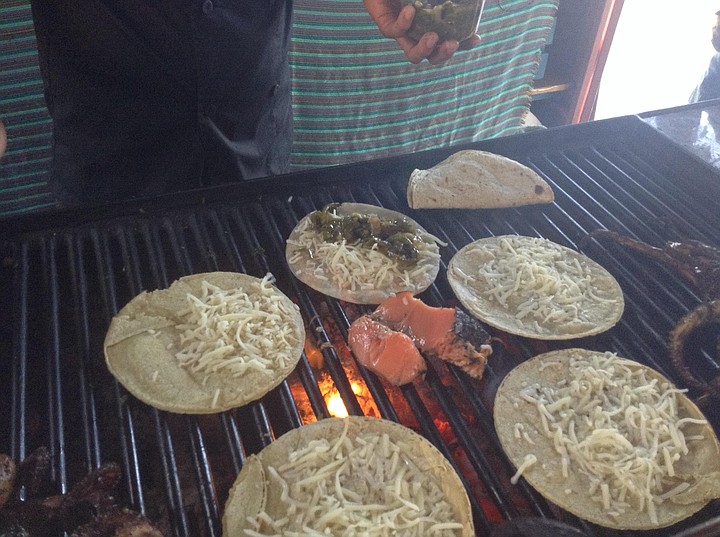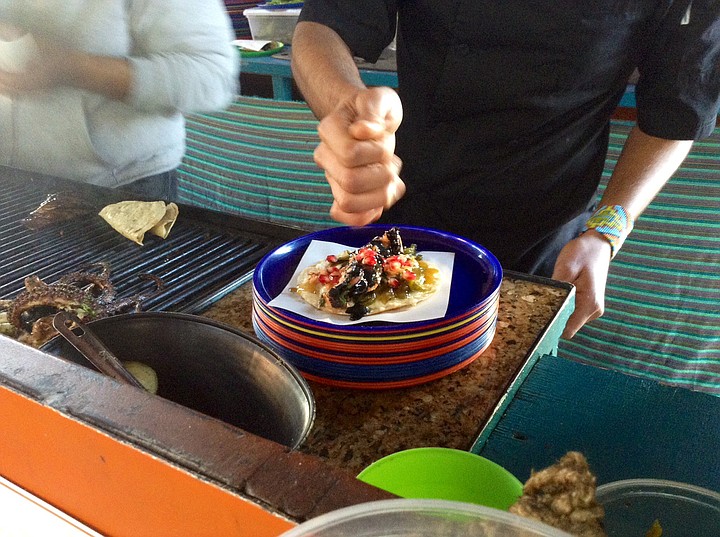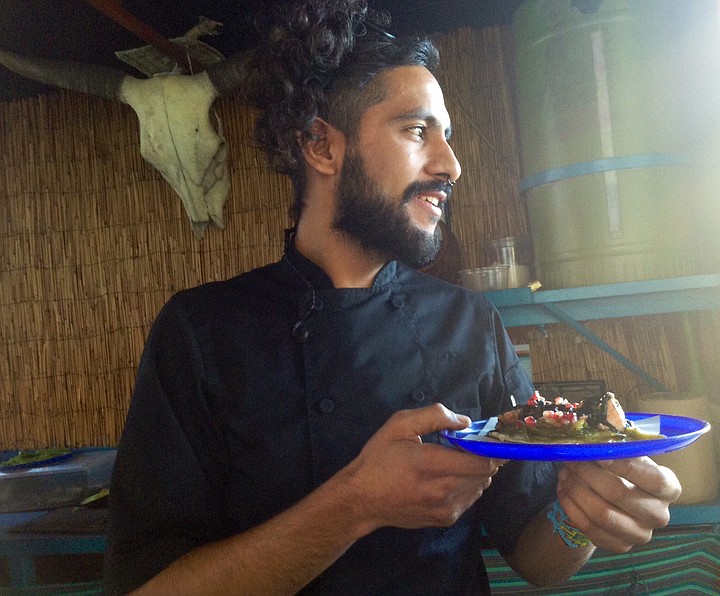 Facebook
Facebook
 X
X
 Instagram
Instagram
 TikTok
TikTok
 Youtube
Youtube

Some people express their thoughts by making speeches, joining movements, speaking out, singing protest songs.
Guillermo “Oso” Campos Moreno does it through cooking. Cooking tacos with a message. On the street, in Tijuana.
Which is pretty incredible already, because at 28, he’s already a veteran: his last job was as a chef at a 3-Michelin-star restaurant in Holland named Oud Sluis.
We’re up Avenida Melchor Ocampo, near where the giant Mexican flag flies.

Oso and his buddy Orlando Miguel Delmonte are working away making tacos for the usual lunchtime line.
Because there always is a line. It’s a taco stand, but not your average taco stand. You know that instantly, from the smells of the mesquite wood-burning grill.

And from the names of the tacos on the menu. “Fin del Mundo.” “Gringo En Vacaciones con Tuxedo.” “Pólvora.”
It’s the Pólvora that I’ve gotta ask Oso about. Because “pólvora” means, uh, gunpowder.
Turns out to be a salmon taco. But it’s prepared so it comes with stripes: red, black and green.
“I like to express my feelings with my food,” Oso says. “We created this taco last September. It’s like our seasonal taco.”
He’s dropping wet pomegranate seeds from his hand down onto my open taco.
“It’s our version of chiles en nogada (chiles in walnuts). Chiles en nogada is green, white and red. That represents Mexico’s flag and we make it especially around Independence Day, 16th of September.”
Except this center stripe is black. What’s the deal?

“We call it ‘Pólvora a la Patria Negra’ (Gunpowder for the Black Nation), representing the counter-[establishment] social movement that’s happening in Mexico. Everything is cultural, political. It’s the way we see things. Like for Day of the Dead, we had this ‘Day of the Dead taco,’ which was made out of the flowers of cempazuchitl (marigolds). They are native to Mexico. They are bright yellow, and for that taco we used them to make an infusion cream, along with saffron. Why saffron? Because it was also a way to represent the conquest of Mexico. It’s an important ingredient in Spanish cuisine. The conquistadors came with their saffron flower and conquered our flowers. So we made our tacos out of the fusion of those two flowers and pistels, and added huitlacoche on the bottom.”
Man. Who knew?
So back to the black stripe in my salmon taco:
“The salmon has a base of chile poblanos,” Oso says, “and then it has this black thing we call ‘chilmolé.’ Chilmolé is the combination of the seeds of different dried chiles, burned completely black. It has some roasted garlic, condiments, and we make a paste of that, and then after the paste is done, you blend it with orange juice, to make it a sauce. And then we cover the whole salmon with it, and add some peppermint and epazote [aka wormseed, Jesuits’ Tea. Tastes like mint, or actually closer to creosote]. Then we smoke it for 25 minutes at 175 degrees, then portion it, and finish it on the grill to make the skin crispy.

“And after that, we re-marinate it with the black sauce, and at the end, we add this mango sauce, which is bright yellow, to represent hope and fire.”
Does everybody know the significance of this taco?
“Most people don’t even ask. They just eat it because they like it. But if anyone is interested, I tell them.”
One thing’s sure: The message delivers the taste. The blackened chiles, the crisp skin, the garlic, the OJ, the mango, the pomegranate seeds, they add up to a totally beautiful combo. Maybe Oso should run for president. With tastes like this, how would he not get his message through?
But I have to ask: working here on the street, does he miss the whole fine-dining thing?
“Of course I miss some of that high-end cooking, like at Oud Sluis. But you work 17 hours a day there, which is really hard. Here, it’s more personal. And you can tell right there on their faces if you did a good job. At the high-end restaurant, you just plate it, ring a bell, and somebody else comes and takes it. It’s more fun here. And I can create whatever variations I want. Or you want. The customer can speak up. It’s your taco.”
More in upcoming cover story.


Some people express their thoughts by making speeches, joining movements, speaking out, singing protest songs.
Guillermo “Oso” Campos Moreno does it through cooking. Cooking tacos with a message. On the street, in Tijuana.
Which is pretty incredible already, because at 28, he’s already a veteran: his last job was as a chef at a 3-Michelin-star restaurant in Holland named Oud Sluis.
We’re up Avenida Melchor Ocampo, near where the giant Mexican flag flies.

Oso and his buddy Orlando Miguel Delmonte are working away making tacos for the usual lunchtime line.
Because there always is a line. It’s a taco stand, but not your average taco stand. You know that instantly, from the smells of the mesquite wood-burning grill.

And from the names of the tacos on the menu. “Fin del Mundo.” “Gringo En Vacaciones con Tuxedo.” “Pólvora.”
It’s the Pólvora that I’ve gotta ask Oso about. Because “pólvora” means, uh, gunpowder.
Turns out to be a salmon taco. But it’s prepared so it comes with stripes: red, black and green.
“I like to express my feelings with my food,” Oso says. “We created this taco last September. It’s like our seasonal taco.”
He’s dropping wet pomegranate seeds from his hand down onto my open taco.
“It’s our version of chiles en nogada (chiles in walnuts). Chiles en nogada is green, white and red. That represents Mexico’s flag and we make it especially around Independence Day, 16th of September.”
Except this center stripe is black. What’s the deal?

“We call it ‘Pólvora a la Patria Negra’ (Gunpowder for the Black Nation), representing the counter-[establishment] social movement that’s happening in Mexico. Everything is cultural, political. It’s the way we see things. Like for Day of the Dead, we had this ‘Day of the Dead taco,’ which was made out of the flowers of cempazuchitl (marigolds). They are native to Mexico. They are bright yellow, and for that taco we used them to make an infusion cream, along with saffron. Why saffron? Because it was also a way to represent the conquest of Mexico. It’s an important ingredient in Spanish cuisine. The conquistadors came with their saffron flower and conquered our flowers. So we made our tacos out of the fusion of those two flowers and pistels, and added huitlacoche on the bottom.”
Man. Who knew?
So back to the black stripe in my salmon taco:
“The salmon has a base of chile poblanos,” Oso says, “and then it has this black thing we call ‘chilmolé.’ Chilmolé is the combination of the seeds of different dried chiles, burned completely black. It has some roasted garlic, condiments, and we make a paste of that, and then after the paste is done, you blend it with orange juice, to make it a sauce. And then we cover the whole salmon with it, and add some peppermint and epazote [aka wormseed, Jesuits’ Tea. Tastes like mint, or actually closer to creosote]. Then we smoke it for 25 minutes at 175 degrees, then portion it, and finish it on the grill to make the skin crispy.

“And after that, we re-marinate it with the black sauce, and at the end, we add this mango sauce, which is bright yellow, to represent hope and fire.”
Does everybody know the significance of this taco?
“Most people don’t even ask. They just eat it because they like it. But if anyone is interested, I tell them.”
One thing’s sure: The message delivers the taste. The blackened chiles, the crisp skin, the garlic, the OJ, the mango, the pomegranate seeds, they add up to a totally beautiful combo. Maybe Oso should run for president. With tastes like this, how would he not get his message through?
But I have to ask: working here on the street, does he miss the whole fine-dining thing?
“Of course I miss some of that high-end cooking, like at Oud Sluis. But you work 17 hours a day there, which is really hard. Here, it’s more personal. And you can tell right there on their faces if you did a good job. At the high-end restaurant, you just plate it, ring a bell, and somebody else comes and takes it. It’s more fun here. And I can create whatever variations I want. Or you want. The customer can speak up. It’s your taco.”
More in upcoming cover story.
Comments